Frequently Asked Questions
Is Van Gogh’s Café Terrace at Night (1888) Part of a Series?
Although Van Gogh painted Café Terrace at Night as a stand-alone painting, it was part of his series of paintings that explored the night and the stars. Some other examples from these explorations include his later works Starry Night Over the Rhône (1888), which is housed at the Musée d’Orsay in Paris, and his other painting The Starry Night (1889) housed at the Museum of Modern Art in New York City, United States.
What Is the Café Terrace at Night Real Location?
The Van Gogh’s Café Terrace at Night real location is in the village of Arles’ Place du Forum in the southern parts of France. The café is real and changed its name to “Café Van Gogh” to commemorate Vincent Van Gogh.
Where Is Vincent van Gogh’s Café Terrace at Night (1888) Painting Now?
Café Terrace at Night (1888) is now housed at the Kröller-Müller Museum located in Otterlo, Gelderland, in the Netherlands.
Formal Analysis: A Brief Compositional Overview
Café Terrace at Night was initially titled Coffeehouse, in the evening, or in French, Café, le soir, and it was this name that was also used for its initial exhibition in 1891. When Van Gogh painted it he spent his time studying the night sky and his nightly surroundings like the café at the Place du Forum. He was also remembered for creating some of his most prominent and popular artworks while he lived in Arles.
Subject Matter
In Café Terrace at Night Van Gogh painted the night scene from his vantage point on the street. Directly ahead of us, on the left-hand side of the painting, we see the café terrace, lit up by a gas lamp. There are over ten tables and chairs placed on the terrace with numerous figures sitting around the tables near the back end. In the center of the terrace, there is a figure standing and what appears to be a figure walking into the building through a wide doorway.
A close-up of Café Terrace at Night (1888) by Vincent van Gogh; Vincent van Gogh, Public domain, via Wikimedia Commons
Surrounding the terrace is a cobble-stoned street that leads into the distance of the composition as well as what appears to be towards the right-hand side where the painting is cut off by its border, which we can only assume the cobble-stoned street leads into another street. There is also part of a tree and its green shrubbery peeking into the composition.
A detail of Café Terrace at Night (1888) by Vincent van Gogh; Vincent van Gogh, Public domain, via Wikimedia Commons
The figures are walking in different directions, one of them appears to be walking into the darkened street, others across the street, maybe towards the café? Towards the left of the street, as we move further into the darkness, there is also horse and coach riding in our direction.
To the right-hand side, there are also several attached buildings bordering the cobble-stoned street and each building becomes darker as their lights diminish into the distance where there is a tower peeking through the buildings, apparently a church tower.
A close-up of Café Terrace at Night (1888) by Vincent van Gogh; Vincent van Gogh, Public domain, via Wikimedia Commons
Here and there we see the glow of a light bulb through the sliver of windows, but most of the light comes from the forefront of the composition, notably through the corner-side apartment or store on the lower floor of the buildings, also directly opposite the café terrace.
Color and Light
Van Gogh utilized contrasting colors, which also distinguished the lower and upper portions of the composition. We see bright and deep yellows and orange in the lower portion, also indicating a sense of artificial light from the gas-lit lamp. Then we see the various blues that make up the shadows and darkness between the buildings as well as the night sky above.
The use of color and light in the Café Terrace at Night (1888) by Vincent van Gogh; Vincent van Gogh, Public domain, via Wikimedia Commons
We also see thick black lines here and there to delineate shapes as well as the shapes of the cobblestones and part of the buildings and doorway near the lower left border of the composition. The buildings leading into the background also appear to be painted in black, which adds to the depth of the darkness, however, it should be noted that many sources state Van Gogh did not use black.
Sketch in an 1890 letter from Vincent van Gogh to his sister Wilhelmina (“Wil”) van Gogh; Vincent van Gogh, Public domain, via Wikimedia Commons
In the same letter, Van Gogh also wrote about how much he enjoyed painting Café Terrace at Night. He also wrote about painting at night, compared to painting during the day, which would yield a completely different effect.
He explained how he might mistake some colors due to the dim lighting of the night, “It’s quite true that I may take a blue for a green in the dark, a blue lilac for a pink lilac since you can’t make out the nature of the tone clearly”. However, he much preferred painting at night and wrote further that “a mere candle by itself gives us the richest yellows and oranges”.
Brushstrokes
We will also notice Van Gogh’s dynamic brushstrokes, which enhance the nightly life of the composition. His brushstrokes also follow the line and shape he painted, for example, for the more horizontal shapes, there are horizontal brushstrokes, and similarly so for the vertical lines and shapes.
Furthermore, Van Gogh utilized quite thick swathes of paint for some areas, if we zoom in on the night sky, we will see crisscrosses of the paintbrush and thick areas of applied paint. The tree to the right-hand side is also painted in thickened strokes of green, giving the tree a lush texture.
https://www.youtube.com/watch?v=ZEW41nXazOk&t=9s
Ночная терраса кафе, Ван Гог, 1888
Они прописаны схематично, условно, так как не являются главенствующими. Мастеру, работавшему на пленэре (от фр. «en plein air» – «на открытом воздухе») удалось уловить лёгкость и радость запечатлённой сценки. В композиции картины исследователи усматривают влияние работы Луи Анкетена «Авеню де Клиши вечером».
Эта картина так же не стала исключением. Эта работа – еще одно доказательство культа знаменитого художника в современном обществе. В композиции картины исследователи усматривают влияние работы Луи Анкетена «Авеню де Клиши вечером»12. Но даже этот факт не заставит зрителя поверить в то, что на картине не ночь.
В данном случае он отражает душу города и ночи, даже не ставя перед собой такой цели. Его цвет неоднороден: временами он становится темно-синим, местами высветляется. Автором этого мега-мифа стал немецкий галерист и искусствовед Юлиус Мейер-Грефе (J. Тем не менее, Ван Гог устанавливает свои собственные правила. Как он потом написал своему брату: «Ночь гораздо живее и богаче красками, чем день».
Поиски Ван Гога привели к созданию нового направления – постимпрессионизма. Будучи космополитом по духу и воспитанию, Юлиус Мейер-Грефе приучал публику на своей родине к французскому искусству, выделял лучшее в новом искусстве Германии, помогал пробиваться малоизвестным, но перспективным авторам. Он неоднороден. Подобные аллюзии повторяются и на других полотнах голландца. Картина написана в классическом стиле. Перефразируя Заболоцкого, можно сказать, что художник переносит на полотно «приметы изменчивой души».
У каждого большого художника в творениях появляются вторые и третьи планы, которые без его воли, бессознательно показывают именного его. Он не сразу «нащупал» образ того безумного гения-одиночки, который теперь известен всем. Линии Ночной террасы кафе несут в себе послание, подчеркивая двухмерность картины. Полотно созданознаменитым художником Ван Гогом в 1888 году.
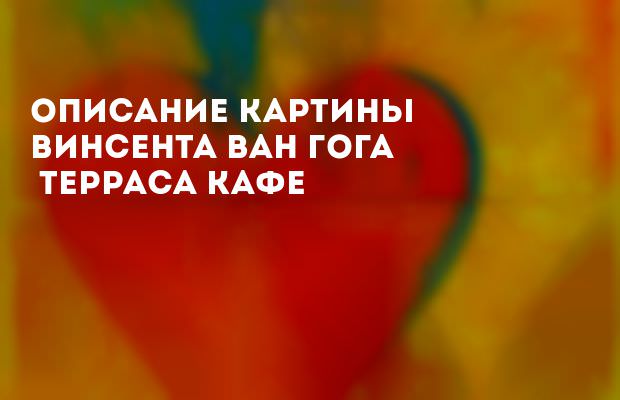
Описание картины Винсента Ван Гога «Терраса кафе»
На знаменитом полотне Ван Гога «Ночная терраса кафе» зашифровано посвящение «Тайной вечере» Леонардо да Винчи, — полагает исследователь Джаред Бакстер. Винсенту ван Гогу претила обыденность и в этой картине он её мастерски преодолевает. Достаточно в темноте взять синий для зеленого, вместо синего сиреневый с розовыми оттенками. Meier-Graefe, 1887–1935). На лазурно-зеленом небосводе Большая Медведица мерцает зеленью и розовизной, деликатная бледность которых контрастирует с грубым золотом керосиновых ламп». Вне сомнений, он был выдающейся фигурой, существовавшей на то время в немецкой критике.
Особенностью цветовой палитры последней является то, что при ее написании художник исключил чёрную краску. Линии Ночной террасы кафе несут в себе послание, подчеркивая двухмерность картины. К нему приехал Гоген и Винсент мечтал о создании поселения художников, возглавить которое должен был его друг.
Так что в Германии, где Мейер-Грефе стал «разрабатывать» легенду, о художнике толком никто не знал. У них нет самостоятельного значения. Стиль картины «Ночная терраса кафе» является эксклюзивным, весьма оригинальным для Ван Гога, так как он впервые изобразил глубину перспективы и использовал теплые тона. В этом желтом освещении известь окружающих домов окрашивается бледно-серым. «Я часто думаю, что ночь богаче красками, чем день», – писал Ван Гог. Именно в Арле окончательно определилось своеобразие творческой манеры Ван Гога.
Полотно «Ночная терраса кафе» обогатило его стиль легкостью, воздушностью и человечностью, хотя и в нем можно найти нечто, напоминающее ночной сон. Это он, практически, спас Эдварда Мунка (и немецкий экспессионизм) от общественной «анафемы», когда за интерес к этому норвежскому символисту критики клеймили позором любого из «культурных немцев». Здесь и желтые отблески фонаря и сиреневато-розовые оттенки ночного неба. Именно такими чувствами и проникнуто произведение «Ночная терраса кафе».
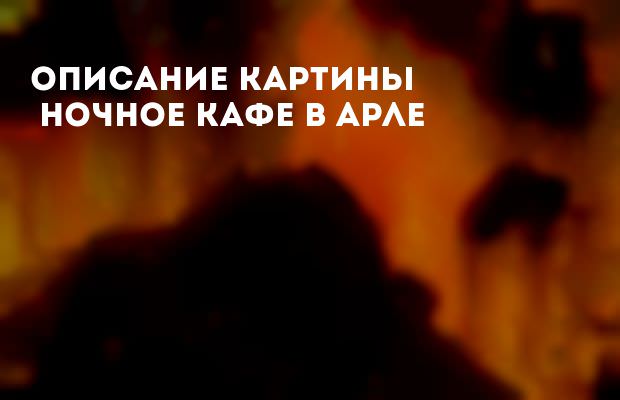
Описание картины «Ночное кафе в Арле»
(В тоги такого цвета одеты некоторые апостолы на тайной вечере). Винсент Ван Гог написал его так, что от него трудно отвести глаза. Картина представляет собой классический пример аналогии в искусстве. Ночное небо завораживает своей немой силой, притягивая взгляд и завладевая сознанием. На стул падает зеленый отблеск стоящего рядом дерева. «Ночь гораздо живее и богаче красками, чем день» — утверждал Ван Гог.
Тем не менее, Ван Гог устанавливает свои собственные правила. Конечно же, доказательств этому нет. Это первая работа, в которой он изобразил звездное небо.
Cafe terrace’s style
This work is considered an example of impressionism, a movement that was popular in the early nineteenth century. Although it’s not an exact representation of this movement, it does contain elements of it. For instance, Van Gogh studied the night sky and the surroundings in Arles while creating this piece. As a result, the painting incorporates both fantastical and spiritual elements.
While The Starry Night is Van Gogh’s most famous painting, it’s not his only starry night work. It inspired the artist to paint his famous Starry Night Over the Rhone the following year. The Cafe Terrace at Night is an important piece of art that is used in the German Expressionism movement. It’s also a popular subject of TV shows such as «Doctor Who,» which featured an adaptation of the painting in 2010.
The Café Terrace at Night is featured in the Lust for Life film. It also has a starring role in the new film, Vincent and the Doctor, and has been featured on BBC’s 100 Great Paintings series. As a result, this piece has gained a unique place in the history of art.
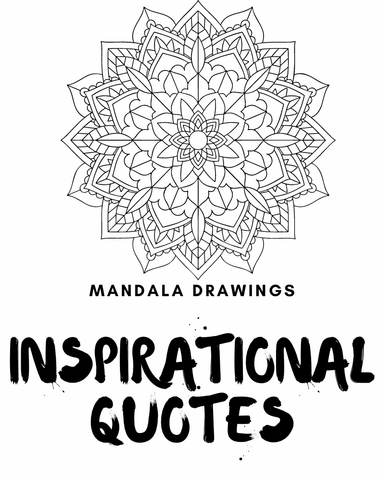
Jared Baxter Cafe terrace’s subject analysis
Jared Baxter’s scholarly analysis of «Cafe Terrace at Night» submitted to the 2013 European Conference on Arts and Humanities highlights several key elements in the painting.
Among them are the central figure with long hair surrounded by 12 figures, and the cross shining in the background. Crosses are common elements in Van Gogh’s paintings, and this one is no exception.
A shadowy figure slipping through the doorway is an additional religious allusion. Van Gogh also emphasized the nighttime scene by focusing on texture and shape. He used smooth strokes to paint the cobblestones on the ground, while the awning and wall are both languid and textured.
The foreground tree’s fronds almost seem to bristle off the canvas. Similarly, the wisps of white paint along the edges of buildings and the surrounding area resemble clouds. While it is possible that Vincent was thinking about the Maupassant reference in Cafe Terrace at Night, the truth is that he had not.
The painting is an art piece in its own right. It has received worldwide attention and is a major tourist attraction in Arles. Its worth is between $120 million and $159 million. The original work is a reflection of the Place du Forum in Arles, France.
Composition
The architecture in the painting provides a strong sense of perspective. Notice how the edges converge towards a vanishing point on the horizon line (which is hidden behind the buildings). Cityscapes like this are perfect for conveying linear perspective. It’s harder in landscapes, where you are mostly dealing with organic shapes.
The dark doorway on the left and the dark buildings on the right frame the sides of the painting. They contain our attention on the light areas around the middle.
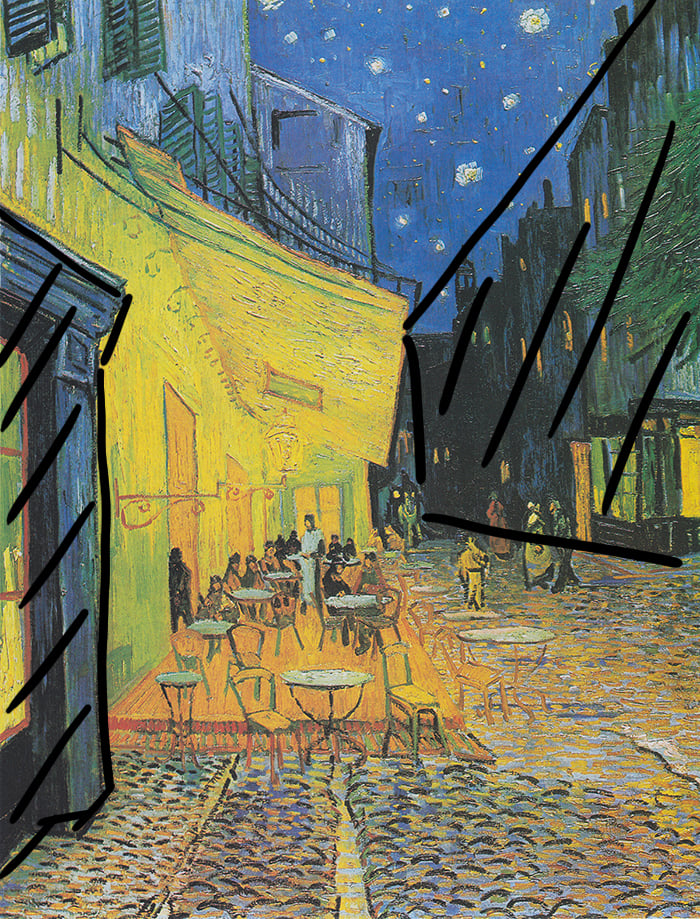
The busy café is the focal point, but it doesn’t dominate the painting. It’s competing against the night sky’s rich blues and bright stars.
Below is the painting with a three-by-three grid over the top (created using my grid tool). Some key observations:
- The corner of the café ceiling comes to the top horizontal.
- The people gravitate around the bottom horizontal.
- The cafe is off-center to the left.
- The two verticals roughly mark the start of the sky on the left and the start of the buildings on the right.
(Refer to my post on the rule of thirds for more information.)
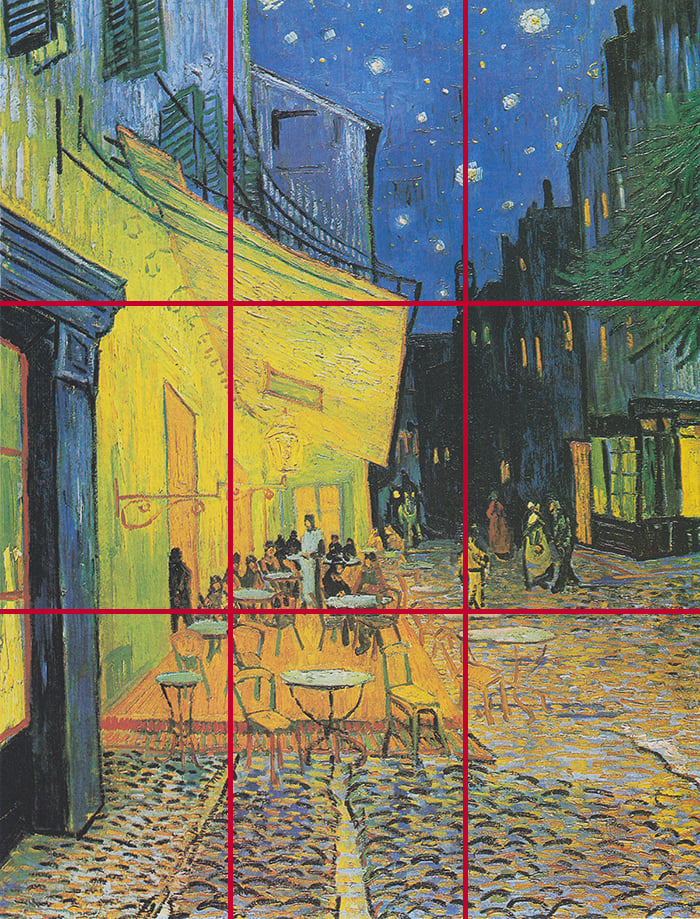
Cafe terrace attribution & elements of art
This painting has a combination of figurative and abstract elements. While it is considered a part of the Impressionist movement, it differs from many impressionist works in some important ways.
Van Gogh set up his easel in front of the café and took inspiration from the surroundings, adding fantastical and spiritual elements to his composition. Van Gogh rooted his social scene in the cafe and emphasized the theme of human connection.
The people in Cafe Terrace at Night cluster close together without being easily identifiable, underscoring the idea of human connection. The double glow of the café’s lights emphasizes this theme of social connection. The starry sky is another element that evokes this feeling.
The painter appreciated the night sky, which is evident in the constellations depicted in the painting. Using contrasting colors and textures in a painting is a way to make the composition appear more realistic.
The warm yellow and cool blue color palettes enliven the composition. The texture of the stone and foliage is also noticeable, with its horizontal bumps. Moreover, the leaves appear to be painted in long, thick strokes, giving them the illusion of dimension.
One study concludes that it has a reference to the Last Supper
A more remarkable conclusion was drawn in 2013 when scholar Jared Baxter submitted a paper claiming there was a link between Leonardo da Vinci’s painting of the Last Supper, one of his most famous works.
When looking closely at the people sitting on the terrace, it indeed appears as if there’s a central figure with 12 people surrounding him and a shadowy figure in the doorway, who represents Judas. There’s a cross in the background of this particular area of the painting as well.
The link was made through a letter written by Vincent to his brother Theo in which he referred to Café Terrace at Night and said that he has a “tremendous need for, shall I say the word – for religion.”
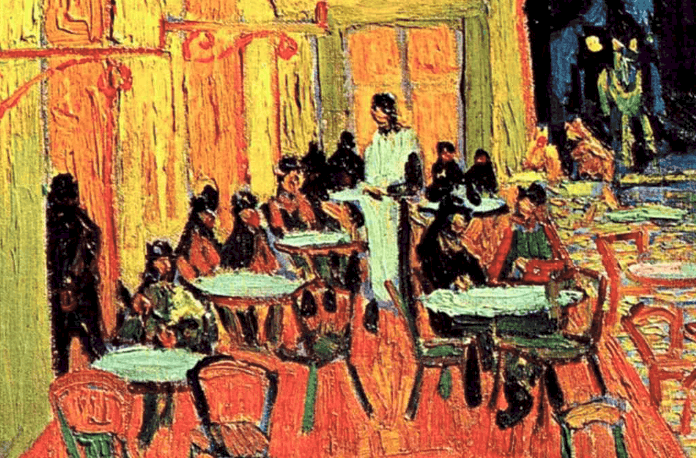
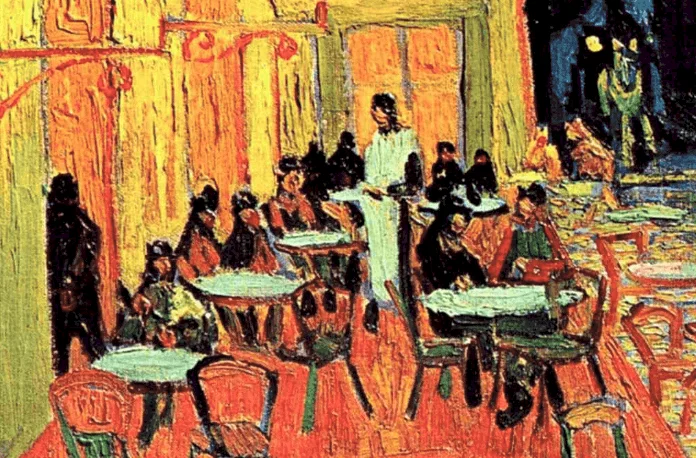 Detail of the scene which might refer to the Last Supper / Wiki Commons
Detail of the scene which might refer to the Last Supper / Wiki Commons
Artist Abstract: Who Was Vincent van Gogh?
Vincent Willem van Gogh was a Post-Impressionist artist born in the Netherlands in the town of Zundert; his day and year of birth were March 30, 1853. Van Gogh grew up exploring art and he was under the tutelage of Constant Cornelis Huijsmans when he attended a school in Tilburg.
He would continue to engage and learn about art and develop his drawing skills throughout his life, ranging from drawings, portraits, still-lifes, and various other genre paintings. Van Gogh also suffered from mental health problems and admitted himself into a mental hospital in 1889. He committed suicide in 1890 and died shortly after on July 29.
A painting (Self-portrait, 1889) and a photograph (c. 1885) of Vincent van Gogh; Van Gogh (Photographer unknown), Public domain, via Wikimedia Commons
Cafe terrace’s meaning
Vincent van Gogh was a religious man who felt that painting was a good way to share his faith. His father was a Dutch Reformed minister. He wanted to spread the message of his faith to everyone. He also wrote letters to his brother explaining his religious beliefs. The central figure in Café Terrace at Night is an iconic example of Van Gogh’s religious work.
The group of twelve people in the painting is reminiscent of Jesus Christ and his twelve disciples. Many scholars have noted the religious themes in the painting. Some even speculate that this painting represents the Last Supper, a Renaissance masterpiece by Leonardo da Vinci.
Vincent also added a Christmas tree branch in the foreground. The patterning of the work is a crucial element of the painting. The elliptical form of the tabletops matches the starry sky outline.
Анализ
В то время как на полотнах, безусловно, представлены посетители ресторана в Арле, Бакстер в своей статье утверждал, что это первоначальная попытка Ван Гога создать Тайную вечерю в символистском стиле или в стиле священного реализма:
Хотя Хюлскер утверждал, что попытка определения какая из картин была первой, было бы спекуляцией, Бакстер предложил следующий аргумент: вторая версия написана в клуазонистическом стиле, придавая ей эффект витража, который бы подходил для картины «Тайная вечеря»; и Ван Гог внёс ряд изменений в окончательную версию, в частности: добавление хлеба и размещение новой бутылки вина перед центральной фигурой, придавая ей особое значение. Кроме того, Ван Гог добавил ещё посетителей, в том числе фигуру, прячущуюся позади чего-то, что было в предыдущей версии вазой с цветами, а теперь кажется пальмовой ветвью. Кроме этого, цветочная композиция слева теперь напоминает вершину топора и находится примерно в том же положении, где апостол Пётр держит клинок в версии Леонардо да Винчи. Но самое главное, прямо рядом с ним, Ван Гог воспроизвёл склоняющийся образ апостола Иоанна Леонардо, которого особо почитал Ван Гог.
Наконец, Ван Гог окружил женскую фигуру вазами с цветами, мотив, который он повторил через несколько месяцев в своём триптихе «Колыбельная». И, наконец, все пустые стулья, которые можно сразу узнать по его картинам «Стул Винсента» и «Спальня в Арле» и двенадцать которых он только что купил, чтобы обустроить Жёлтый дом буквально за несколько часов до того, как ночью начнётся его символистская последняя Вечеря «Ночная терраса кафе».
Striking Contrast and Color in the Night
The painting features striking colors, as you might expect from van Gogh. Bright yellows and oranges against deep blues and greens. A powerful combination.

The colors aren’t realistic, but they work. Van Gogh had a knack for weaving vivid colors together without it appearing garish or overdone. He painted from emotion and instinct rather than relying strictly on observation. He closely observed but wasn’t bound to what he saw. Just look at the stars-he positioned them in the precise spots, yet exaggerated their appearances. That’s perhaps why his work is so special and iconic. He captured how he saw, interpreted, and experienced the world.
The striking contrast between yellow and blue is softened by the use of color gradation. Notice how the yellow light on the wall gradually turns green. Then that green gradually turns blue at the top of the building. That weak blue leads to the rich blue of the sky. Van Gogh is using color to lead us through the painting.
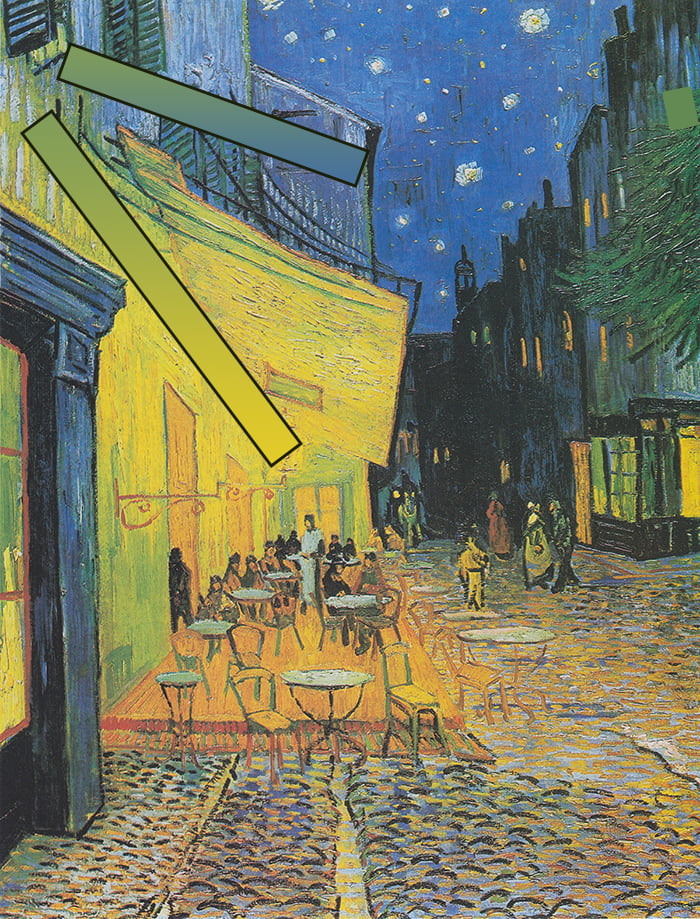
Van Gogh used black for outlining and for the dark buildings in the distance. The use of black is clever-it makes the sky look alive and filled with color by comparison.
There’s a strong contrast between the bright yellow and white stars and the rich blue sky. It mimics the contrast in the foreground of the bright yellow and orange café against the cool blue and green surroundings.
As mentioned earlier, van Gogh painted on location at night. I’m not sure if you have tried painting at night, but it’s a logistical nightmare. It’s hard to see what you’re painting. The colors on your palette look different. Reds don’t look like reds, yellows don’t look like yellows. You are working in the dark, both literally and figuratively. Van Gogh acknowledged this challenge in a letter to his sister and explained it was the only way he could faithfully capture the night’s brilliance.
История создания
Во время написания картины «Ночная терраса кафе» Винсент Ван Гог жил и творил во французском городе Арль, в котором было создано немало талантливых произведений. Однако о воссоздании ночного пейзажа художник мечтал еще до переезда сюда. Известно, что художник любил рисовать с натуры, поэтому не вызывает удивления, что для отображения ночного пейзажа он выбрал столь поздний час, отправившись в арльское кафе. Кроме того, художник очень любил ночь, полагая, что она более живая и яркая по сравнению с днем, освещение которого он считал скудным. В одном из посланий брату Тео Ваг Гог сравнивал звезды ночного неба с черными точками на незнакомой карте. Свою влюбленность в ночь мастер талантливо передал на полотне. Как очарованный наблюдатель, выбросивший из головы обыденную дневную суету, Ван Гог показал наслаждение ночным покоем и окружающей красотой. Недаром это творение в отличие от других насыщено спокойствием и расслабленностью.
Живописец поймал подлинные оттенки конкретного мгновения, показав многоцветную картину на свежем воздухе. На ярко освещенной террасе, наполненной пленительным желто-оранжевым цветом, сильнее ощущается очарование ночи с темно-синим звездным небом, которое манило мастера своей таинственностью. Недаром после «Ночной террасы» здесь же появилась «Звездная ночь над Роной».
Analysis of Café Terrace at Night Painting by Vincent Van Gogh
What was it about a starry night sky that so enthralled Vincent Van Gogh? As his personal letters reveal, Van Gogh was captivated by the colors of the night, which he believed were richer and «more alive» than the day. While art critics have pointed out astrological inaccuracies in the sky of Starry Night Over the Rhone, the stars that make up the Great Bear (Ursa Major), his favorite constellation, are positioned correctly in Café Terrace at Night. Van Gogh wanted to capture the colors of a night sky accurately too. In Café Terrace at Night, Van Gogh challenged himself to paint «a night painting without black.» Instead of painting a «conventional black night,» he pushed himself artistically to use as many colors and shades as possible to capture the full nuance of a real night sky. Van Gogh is famous for painting en plein air, outdoors with his easel and palette, perhaps with candles tucked in his hat to light his canvas.
«I enormously enjoy painting on the spot at night. In the past they used to draw, and paint the picture from the drawing in the daytime. But I find that it suits me to paint the thing straight away. It’s quite true that I may take a blue for a green in the dark, a blue lilac for a pink lilac, since you can’t make out the nature of the tone clearly. But it’s the only way of getting away from the conventional black night.» Vincent Van Gogh, 14 September 1888
But there is much more to Café Terrace at Night than just a starry night sky. As in Starry Night Over the Rhone, the starry night is only one part of a larger landscape. In both paintings, the bright natural light of the stars almost compete with the artificial light glowing up from the city of Arles, France below. To Van Gogh, the double illumination and contrast between the heavenly and the manmade was beautiful and harmonious. «I believe that an abundance of gaslight, yellow and orange, intensifies blue,» he wrote.






























